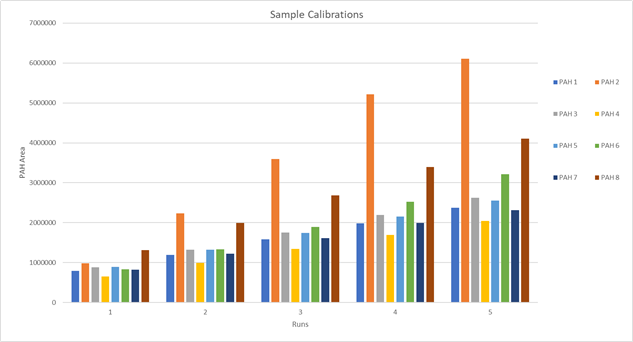Introduction
This study discusses Polycyclic Aromatic Hydrocarbons, which are also called PAHs, as specific chemicals materials that present huge risk for the environment, animals, and human beings. These materials are formed as a result of process of combustion of different materials. The project also mentions the process of calibration and present a figure which clearly shows that PAH 2 and PAH 8 show the highest abundance in each calibration. After that, specific evidence is presented on the point that PAHs are extremely harmful for human health. The study discusses both occupational exposure and prolonged exposure for a long period of time and the effects it has on the physical well-being of individuals. Finally, the main sources from which individuals receive the doses of PAHs are presented.
Results & Discussion
It should primarily be discussed that Polycyclic Aromatic Hydrocarbons, also known as PAHs, are a specific group of chemicals that appear naturally in coal, gasoline, and crude oil. They are formed “during incomplete combustion of organic materials like wood and fossil fuels and petroleum products” (Rengarajan 182). By calculating the concentration of PAHs during calibration and understating the calibration curves, it is possible to make conclusions about the ratios, the peak areas of PAH, and determine ich PAHs have the highest abundance in each calibration. For example, after looking at the following figure it becomes clear that PAH 2 and PAH 8 show the highest abundance in each calibration.

These materials are suggested to be highly toxic to various life forms, such as humans, animals, and the environment. For instance, exposure to high levels of PAHs over a specific period of time can lead to different negative symptoms as eye irritation, vomiting, nausea, diarrhea, and confusion (Abdel-Shafy and Mona 114). Talking about a prolonged exposure to lower levels of pollutants that contain Polycyclic Aromatic Hydrocarbons, it is largely associated with cancer. As suggested by Moorthy et al., “excessive exposure to PAHs often results in lung cancer, a disease with the highest cancer mortality in the United States” (5). Based on this fact it can be claimed that the biggest number of PAHs received by human beings comes from air population that enters the organism through inhaling. Masiol proved that even through individuals receive harmful amounts of PAHs through domestic heating, which is considered to be the main source of these material in winter, outside pollution, such as traffic, is responsible for great amounts of carcinogenic and mutagenic PAHs during the whole year (375).
Conclusion
To summarize, Polycyclic Aromatic Hydrocarbons are specific material that are formed from wood, gasoline, fuel, and petroleum. Through the process of calibration, it is possible to determine which PAHs are predominant and achieve the highest abundance in each calibration. Additionally, an essential finding is that PAHs are extremely harmful materials which are associated with severe symptoms when being exposed to in large amounts right away and cancer diseases when being exposed to for a long time in small amounts. Since the most popular type of cancer associated with PAHs is lung cancer, it can be claimed that people are generally exposed to these harmful materials through air pollution.
Works Cited
Abdel-Shafy, Hussein I., and Mona SM Mansour. “A review on polycyclic aromatic hydrocarbons: source, environmental impact, effect on human health and remediation.” Egyptian journal of petroleum, vol. 25, no. 1, 2016, pp. 107-123.
Masiol, Mauro, et al. “Carcinogenic and mutagenic risk associated to airborne particle-phase polycyclic aromatic hydrocarbons: a source apportionment.” Atmospheric Environment, vol. 60, 2012, pp. 375-382.
Moorthy, Bhagavatula, Chun Chu, and Danielle J. Carlin. “Polycyclic aromatic hydrocarbons: from metabolism to lung cancer.” Toxicological Sciences, vol. 145, no. 1, 2015, pp. 5-15.
Rengarajan, Thamaraiselvan, et al. “Exposure to polycyclic aromatic hydrocarbons with special focus on cancer.” Asian Pacific Journal of Tropical Biomedicine, vol. 5, no. 3, 2015, pp. 182-189.